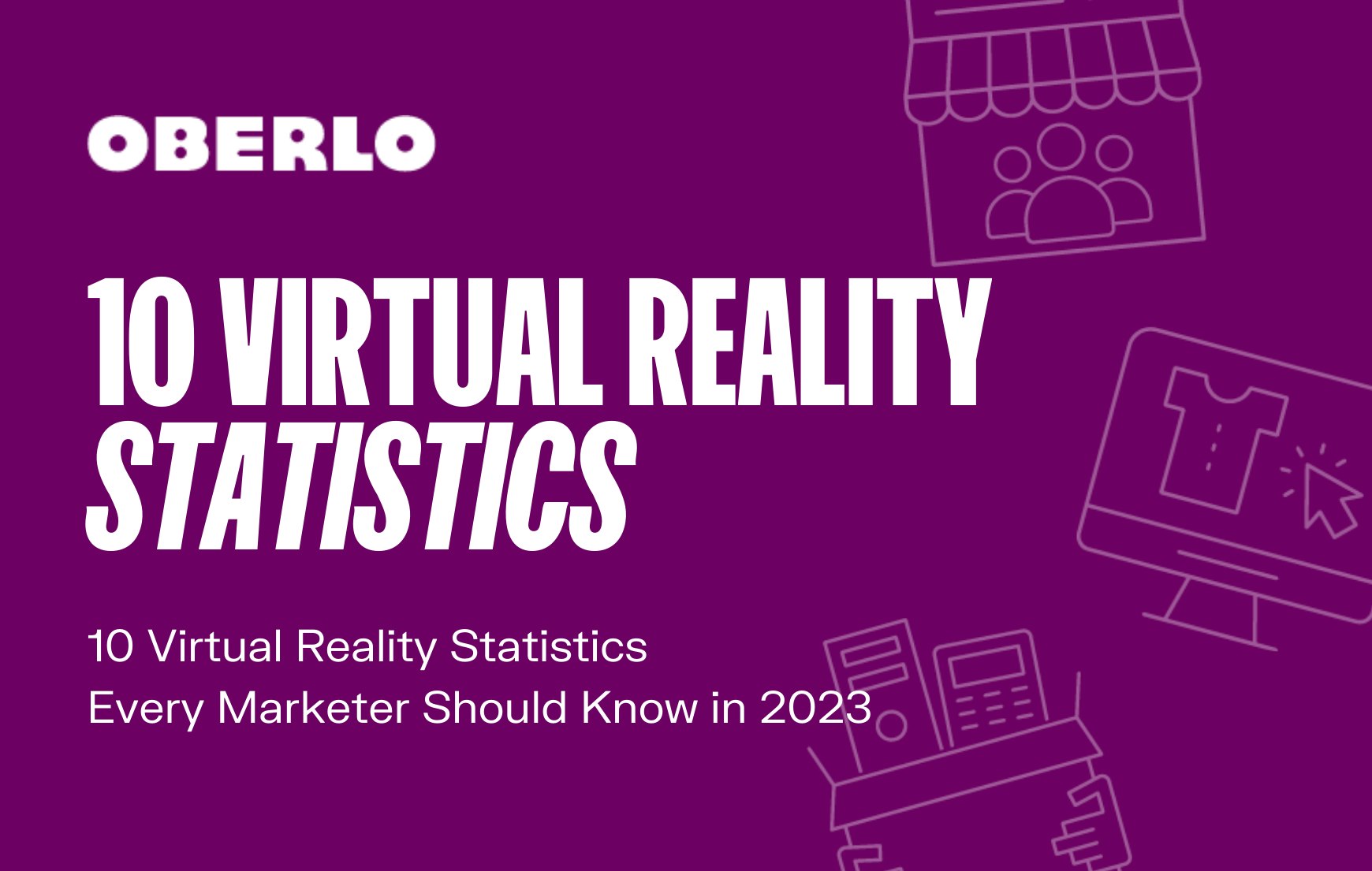Despite it being a relatively nascent technology, the adoption of virtual reality across companies, organizations, and even governments worldwide has been widespread as its potential becomes clearer with every new development.
But what is virtual reality, what benefits does it offer, and what sectors are driving its growth? If you’re looking for answers to these questions and more, you’ve come to the right place.
In this article, you’ll learn ten virtual reality statistics you need to know in 2023. From growth figures to virtual reality future predictions on usage, we’ve got you covered.
Post Contents
- What Is VR?
- 1. Augmented Reality (AR) and Virtual Reality (VR) Market Size
- 2. Virtual Reality Growth
- 3. Increasing Demand For AR and VR Devices
- 4. Virtual Reality Facts: Popularity Increase
- 5. Virtual Reality Usage in the US
- 6. Virtual Reality: Future Predictions on Economy and Employment
- 7. Sectors Driving Virtual Reality Growth
- 8. Virtual Reality Growth in the Gaming Market
- 9. VR Investments by Country
- 10. Key Players in the Virtual Reality Market
- Conclusion
- Summary: Virtual Reality Statistics
- Want to Learn More?



What Is VR?
Before we jump into the statistics, let’s very quickly cover what virtual reality is.
Virtual reality is pretty much as its name suggests. It is a digitally created, three-dimensional environment generated using advanced computer technology. It places users in a simulation and allows them to immerse themselves in a different world.
→ Click Here to Launch Your Online Business with Shopify
This is done with the use of special devices such as headsets, goggles, gloves, and more, which allows users to explore and interact with these virtual worlds and their elements.
Now let’s jump into how popular VR has become and some of the driving factors behind its growth.
1. Augmented Reality (AR) and Virtual Reality (VR) Market Size
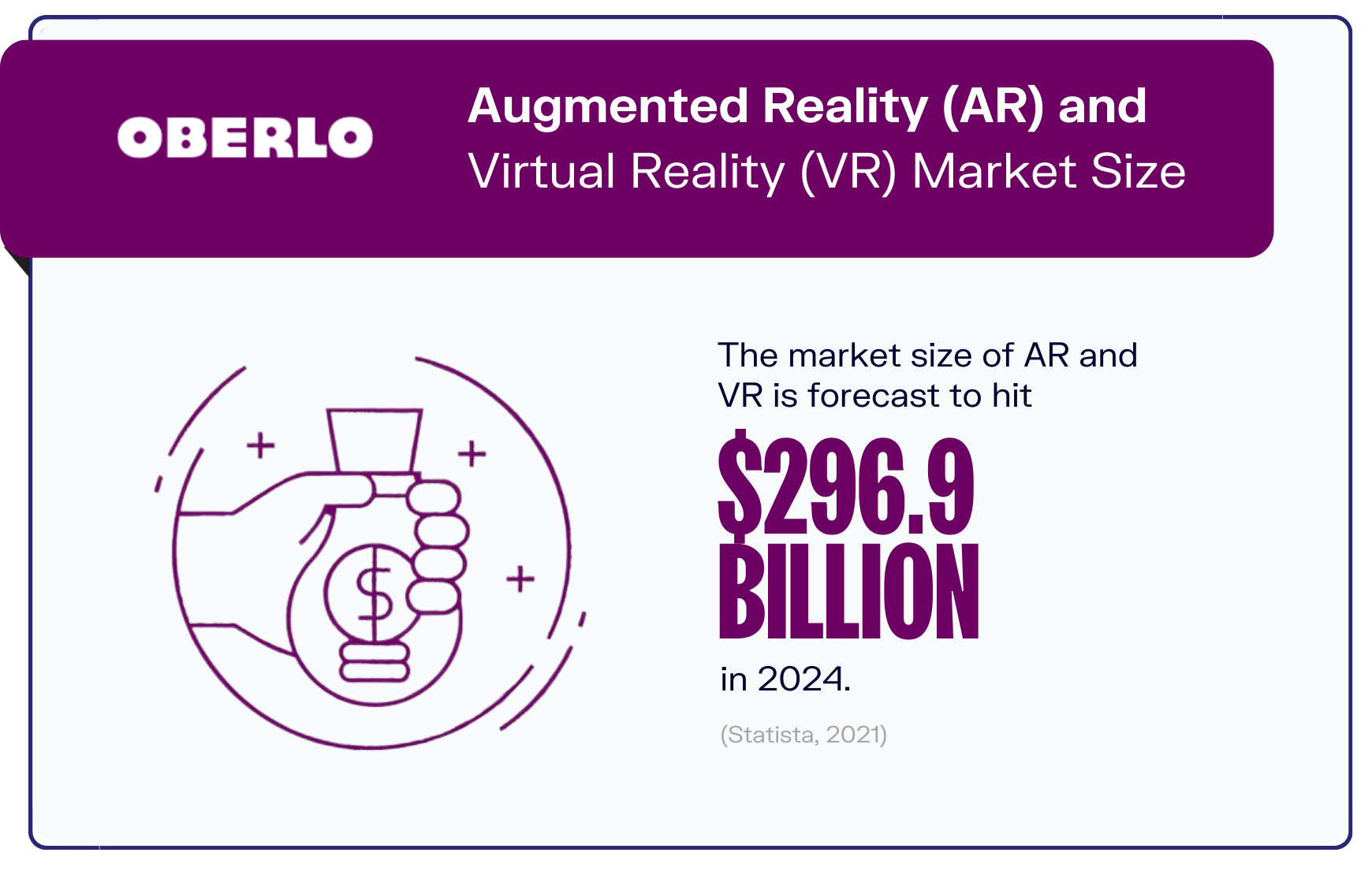
To kick things off, let’s take a look at the sector’s market size.
The latest virtual reality statistics show that the global market size of AR and VR is forecast to hit $296.9 billion in 2024 (Statista, 2021). This is nearly ten times the $30.7 billion market size registered as recently as 2021.
As it is, the figure for 2022 was already a whopping 91.2 percent year-over-year increase. This is set to more than double to $124.4 billion in 2023, before skyrocketing in 2024. The growing market size only goes to show just how popular the technology is expected to become over the next few years.
Even though AR and VR devices still aren’t quite as in-demand as other electronics like smartphones or smartwatches, the growing market size is a clear indication of their potential. Many tech companies such as Microsoft, Intel, and Sony have invested large amounts of money into developing and advancing VR.
As we’ll see in the next statistic, this growing popularity of VR is likely to continue at least for another few years.
2. Virtual Reality Growth
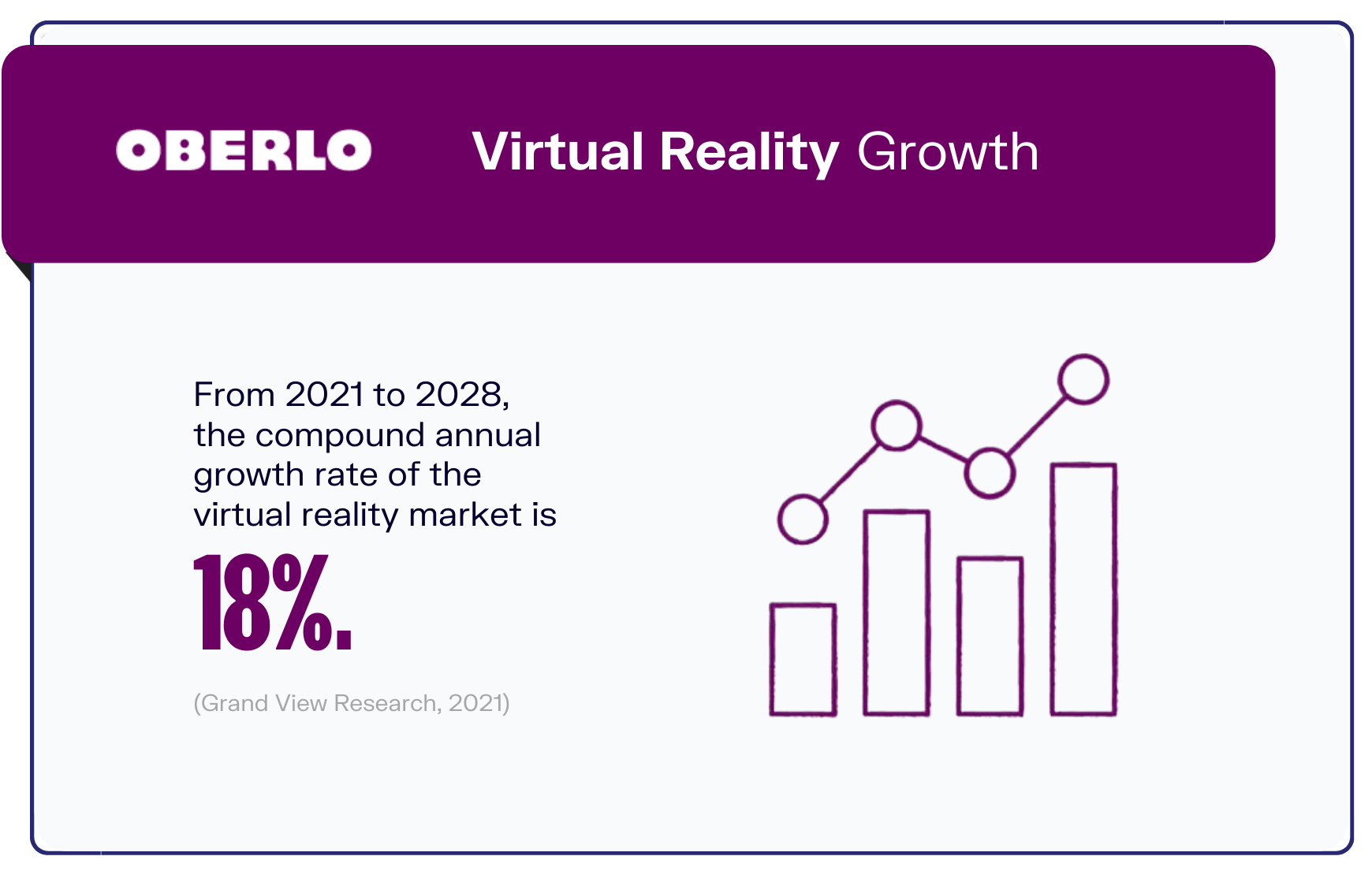
Going forward, all signs point to a surge in the virtual reality market.
Between 2021 and 2028, the compound annual growth rate of the market is expected to come in at 18 percent (Grand View Research, 2021). In other words, in this seven-year period, the VR sector is expected to grow at an average of 18 percent every year.
Analysts say that the oil and gas and manufacturing industries are expected to be the primary driving forces of this growth. In particular, the use of VR in training workers like mechanics, pilots, and technicians is set to increase.
The incorporation of VR for commerce has been particularly popular among businesses and organizations.
One example of this includes UK company ASOS adopting the technology in an effort to boost fashion sales amid the coronavirus pandemic. Using VR, the ecommerce company digitally fitted models with their new designs. This way, not only could their models comply with social distancing regulations and not have to go to the studio to try on these products, but ASOS could also successfully and creatively market their products to their customers in lockdown.
3. Increasing Demand For AR and VR Devices
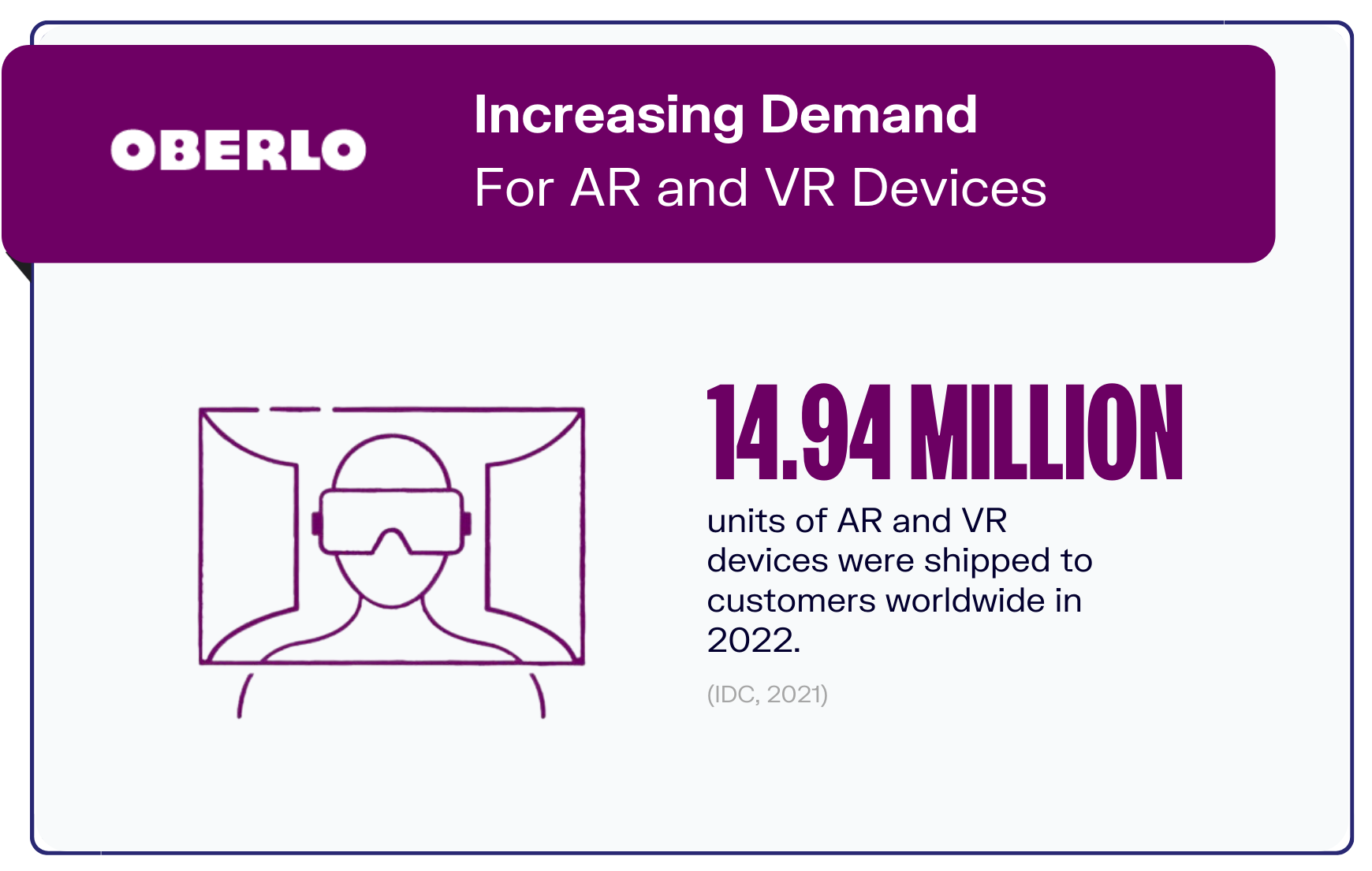
Given the potential and benefits of virtual reality technology, it should come as no surprise that the demand for AR and VR headsets is set to gain further traction in the near future.
As it stands, 14.94 million of these devices were shipped out in 2022, a 54.2 percent increase from 2021’s 9.69 million (IDC, 2021). The majority of these were VR devices, which represented 91 percent of the total number of VR and AR devices that were expected to be shipped out last year.
That’s not all—this number is expected to increase further to 23.22 million in 2023, and further soar to 32.76 million in 2024. By 2025, experts estimate that 43.87 million devices will be shipped worldwide. This will represent an impressive increase of more than seven-fold from 2020 to 2025.
Analysts credit the AR and VR boom to the coronavirus pandemic, which sent the world into lockdown and forced offices to close and employees to work from home. As contact is cut off from the rest of the world, many companies and employees started to adopt AR and VR technology to remote work and attend events.
4. Virtual Reality Facts: Popularity Increase
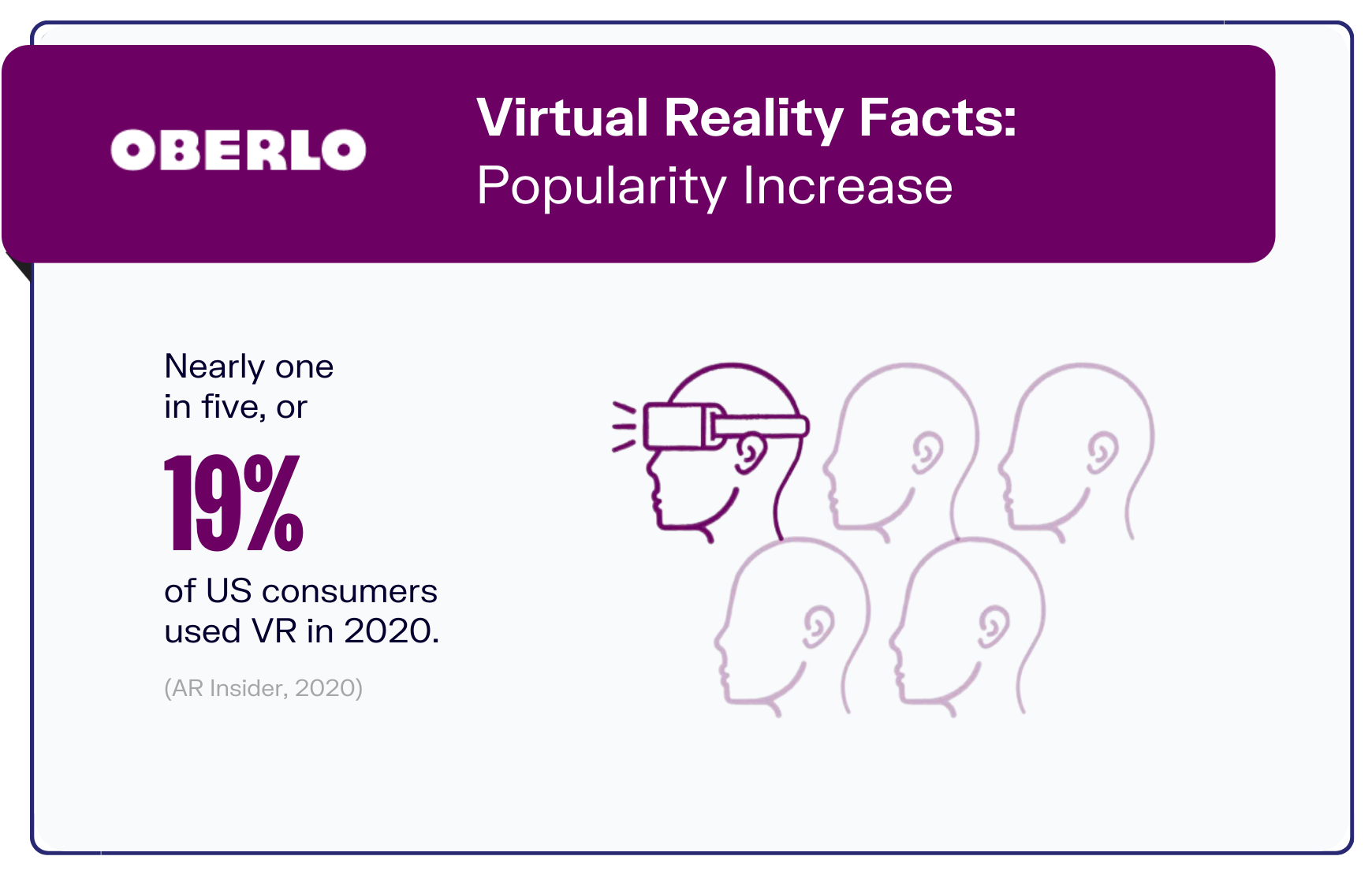
The US market is no exception to this virtual reality growth sweeping across the globe.
Nearly one in five (19 percent) of US consumers used VR in 2020—a three percentage point increase from 16 percent in 2019 (AR Insider, 2020). Most users are also happy with the experience, with 55 percent of them saying they’re either extremely or moderately satisfied.
Since content encourages repeat use, which is one of the biggest factors of success, this is good news for the VR market.
Not all is fine and dandy, however. The barrier to VR use is still particularly troublesome to overcome. Consumers who do not use the tech say they’re simply not interested in giving it a try or discovering it, which will prove to be a challenge for VR developers.
5. Virtual Reality Usage in the US
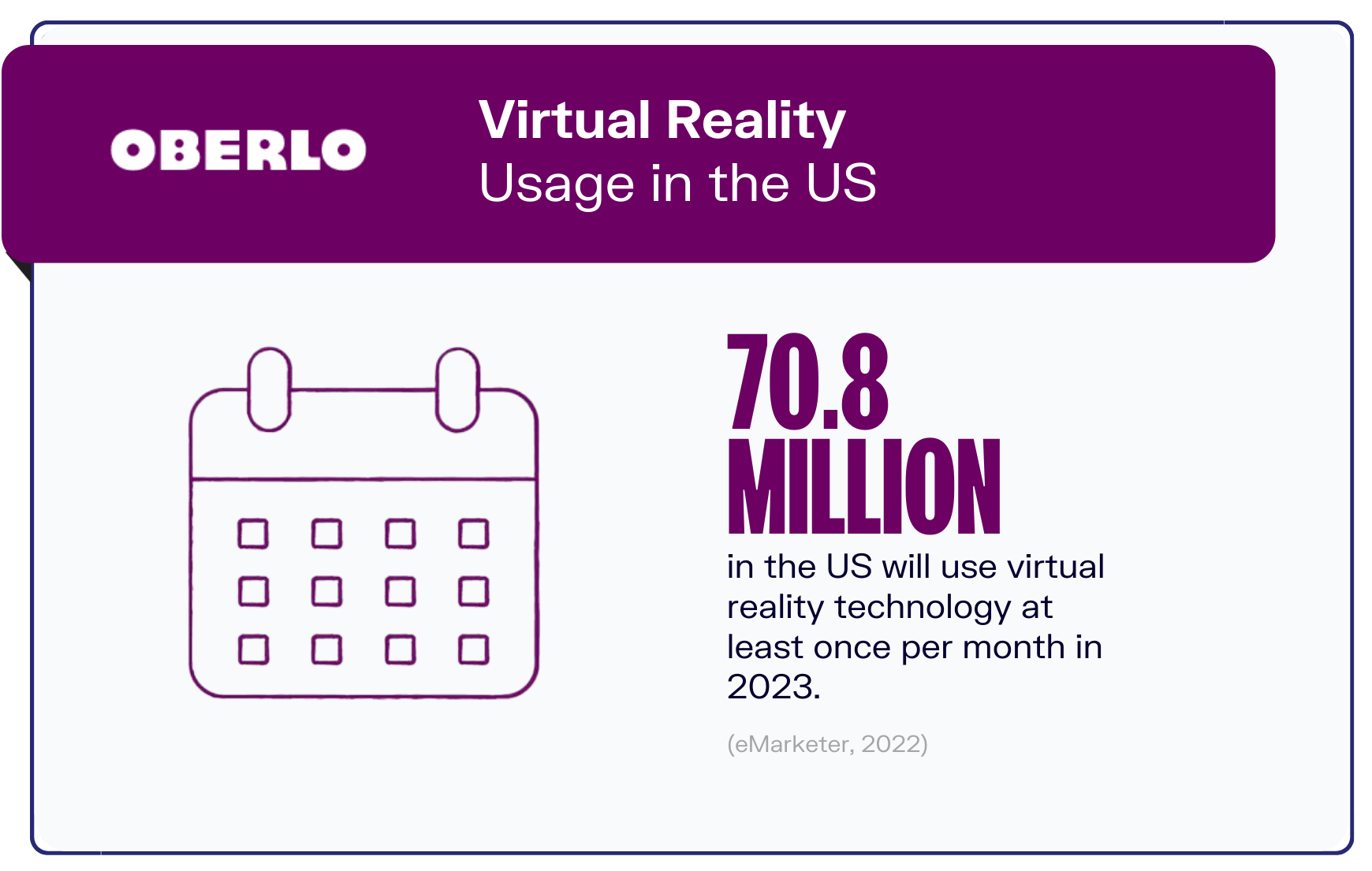
As more and more people in the US purchase VR sets, usage can be expected to increase along with it.
The latest virtual reality statistics show that 70.8 million people in the US will use the technology at least once per month in 2023 (eMarketer, 2022).
This marks a six percent annual increase from 2022’s 66.8 million, and an overall increase of 39.6 percent from 2020.
More and more US residents are also expected to start using VR more frequently. This number is expected to increase to 73.7 million in 2024 and by 2025, experts estimate there will be 75.4 million VR users in the US.
If the predictions hold true, this means that in the five-year period from 2020 to 2025, the number of people using VR every month will have increased by a whopping 48.7 percent.
6. Virtual Reality: Future Predictions on Economy and Employment
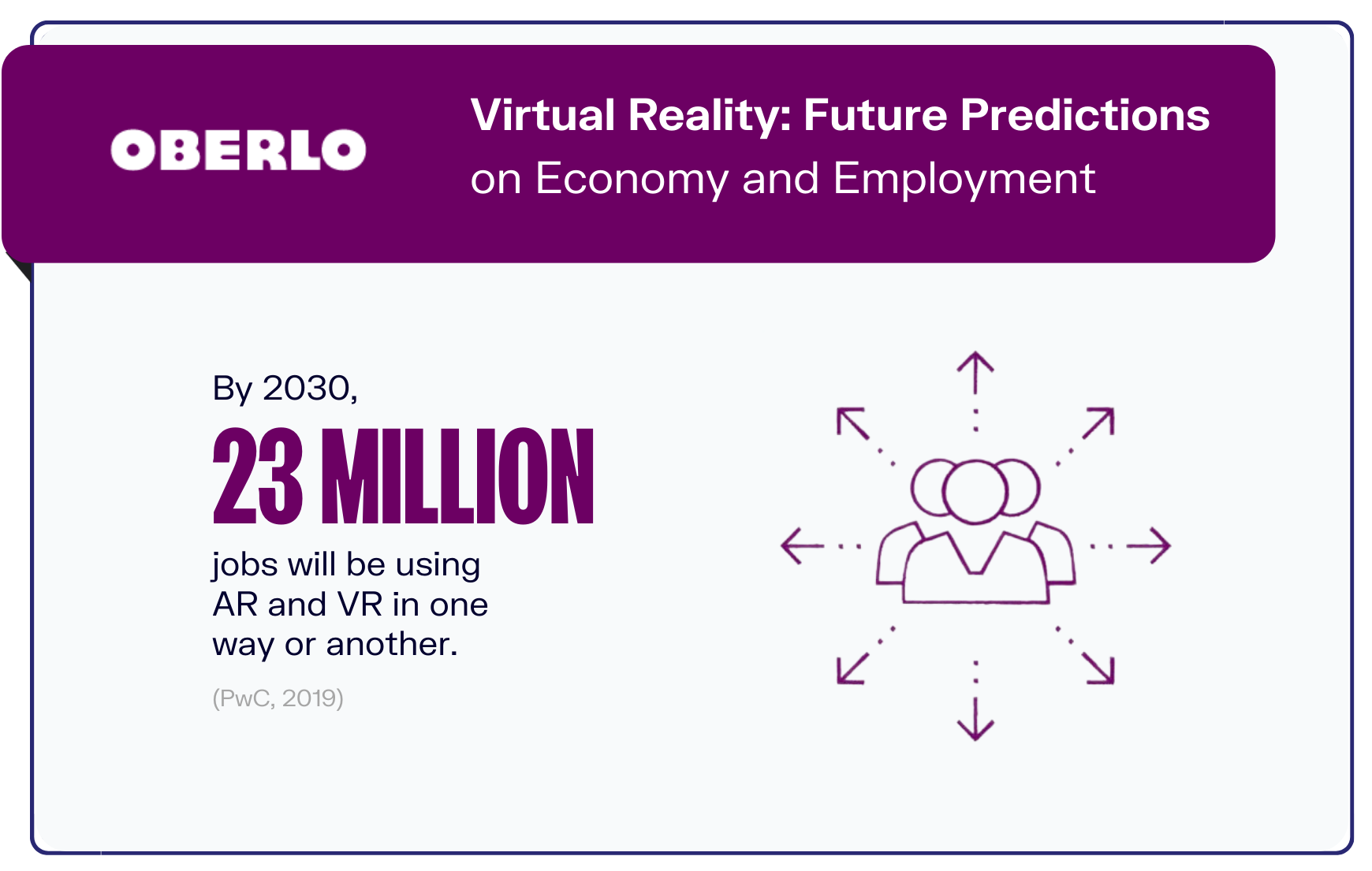
Experts also expect virtual reality to bring about economic advantages.
A recent analysis by leading consulting services firm PricewaterhouseCoopers purports that the tech is capable of injecting approximately $1.83 billion into the world economy by the end of this decade.
The report also predicts that VR will lead to a growing number of employment opportunities.
Right now, there are fewer than half a million jobs worldwide that are impacted by VR and/or AR. This will all change this decade, with as many as 23 million jobs set to be using AR and VR in one way or another for training, meetings, and customer service purposes by 2030 (PwC, 2019).
Larger economies, including the US, UK, Germany, and China, are expected to be the most impacted.
7. Sectors Driving Virtual Reality Growth
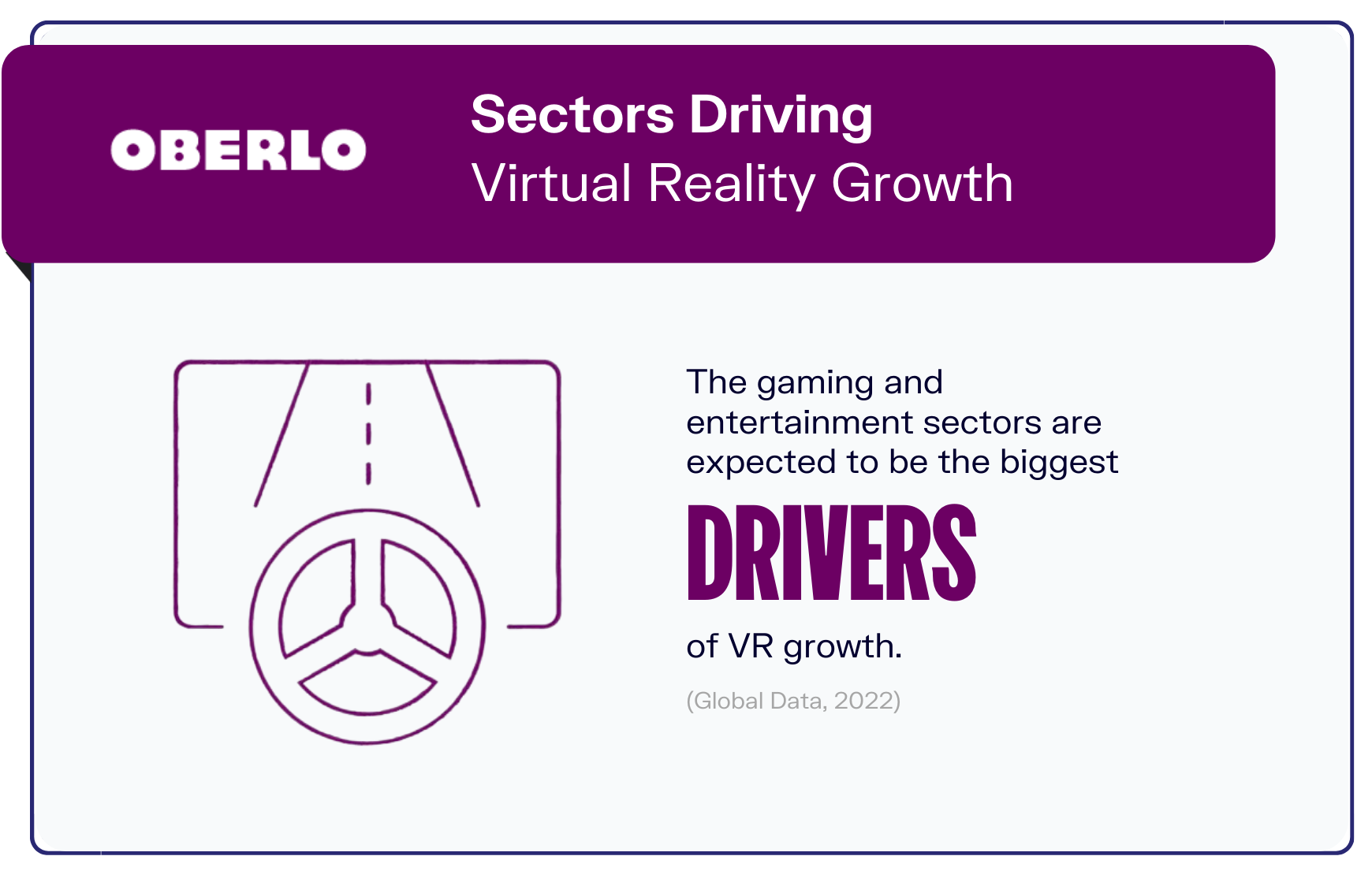
This then begs the question: What are some of the key drivers behind such impressive growth?
According to a recent report, the gaming and entertainment sectors are expected to be the biggest drivers of VR growth worldwide (Global Data, 2022).
With not much other than a headset needed to play a VR game, it makes it easy and convenient for gamers to just pop the device on, launch, and be taken to an entirely different world. The demand for VR games also surged during the COVID-19 pandemic, as consumers spent more time gaming.
Entertainment companies have also been eager to implement the technology. These include the use of VR holograms in theme park rides at the London Thorpe Park as well as the launch of Mario Kart VR by a video game development company.
VR is also popular in other sectors like education. For instance, it is used to train doctors and aircraft pilots. Because of the nature of such jobs and the high costs of mistakes, the simulation permitted by virtual reality makes it a practical solution as it allows them to practice in a safe environment.
8. Virtual Reality Growth in the Gaming Market
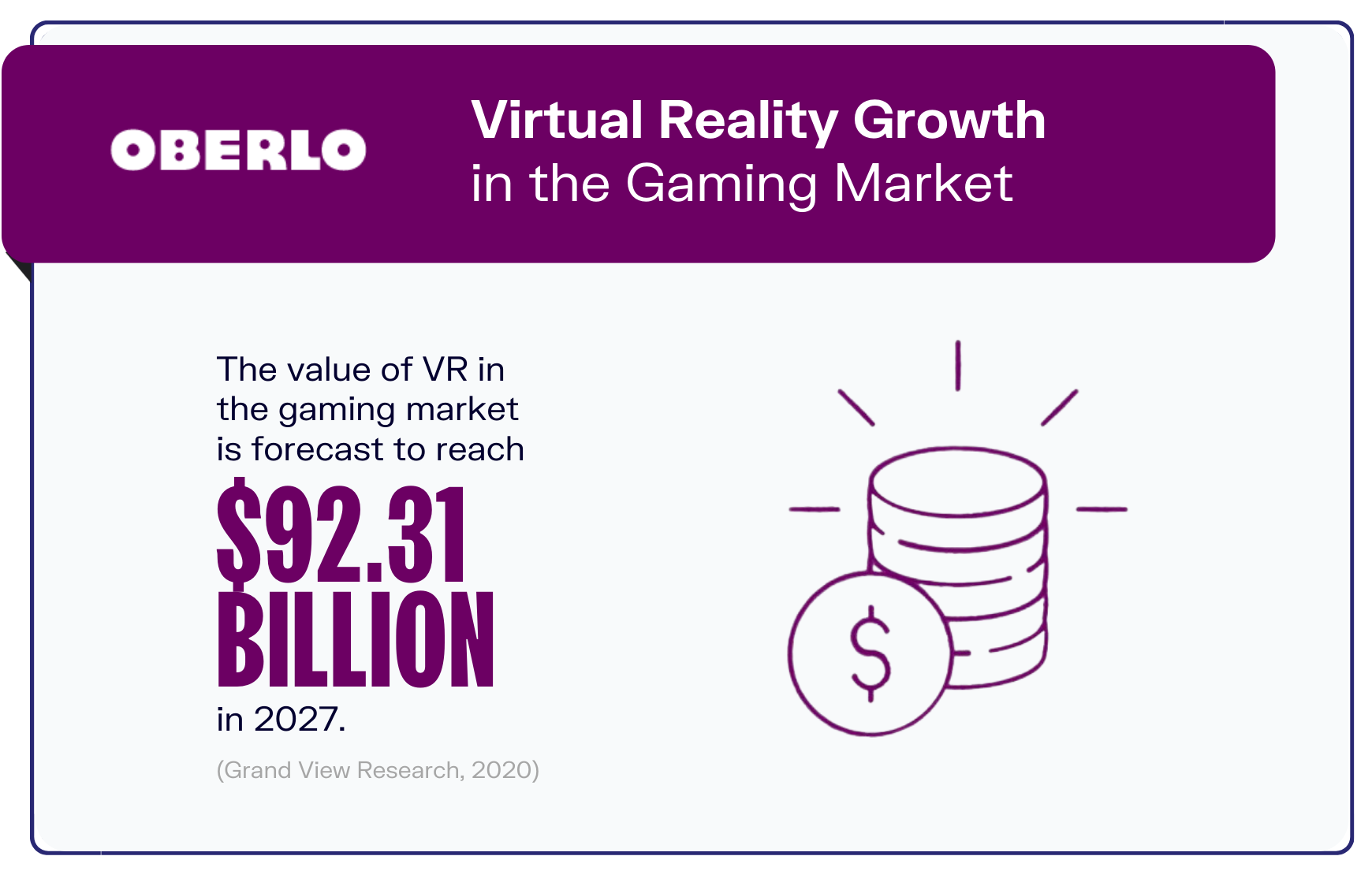
Given the demand for VR in gaming, it should come as no surprise then that more and more gaming companies will be adopting the technology as demand for it grows.
In fact, the global virtual reality in the gaming market is forecast to grow rapidly over the next few years.
According to the latest virtual reality statistics, by 2027, its value is forecast to reach $92.31 billion, which marks a compound annual growth rate of 30.2 percent in the seven-year period between 2020 and 2027 (Grand View Research, 2020).
The biggest driver of this is expected to come from millennials, whose demand for tech-advanced games will push game developers to rely more on VR to meet rising standards.
9. VR Investments by Country
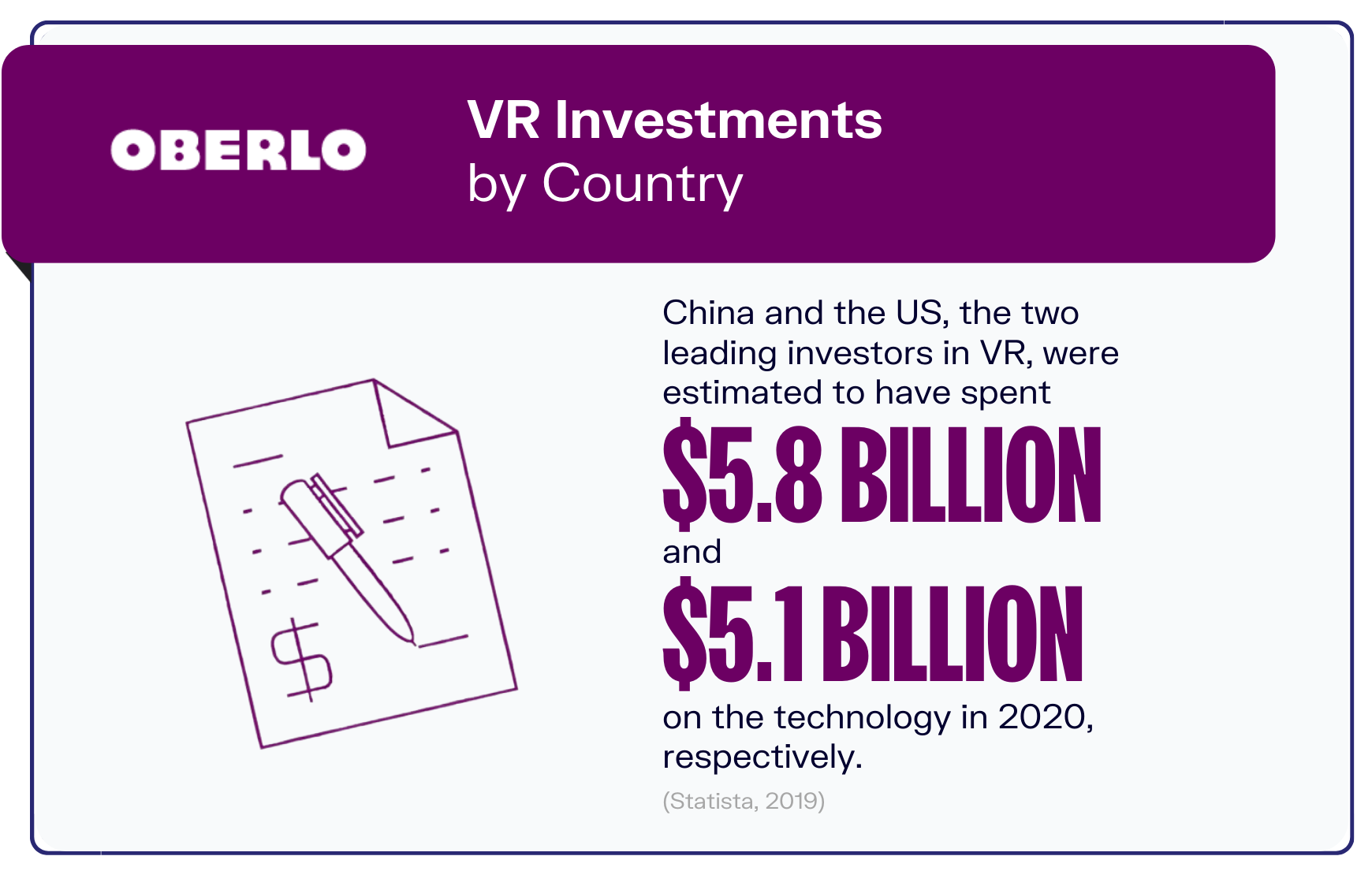
Though VR investments are expected from a multitude of countries worldwide, there are a select few that will be leading the pack.
Asian giant China is at the top of this list, with an expenditure of $5.8 billion on the technology in 2020 (Statista, 2019). This is a significant amount. In fact, its spending projection made up 30.8 percent of the total amount ($18.8 billion) that was spent on VR globally.
The US is the second-largest investor and spent $5.1 billion on virtual reality technology. Together, the US and China were responsible for 58 percent of the global VR investment in 2020.
This was followed by the entire Western Europe bloc with $3.3 billion and Japan with $1.8 billion.
10. Key Players in the Virtual Reality Market
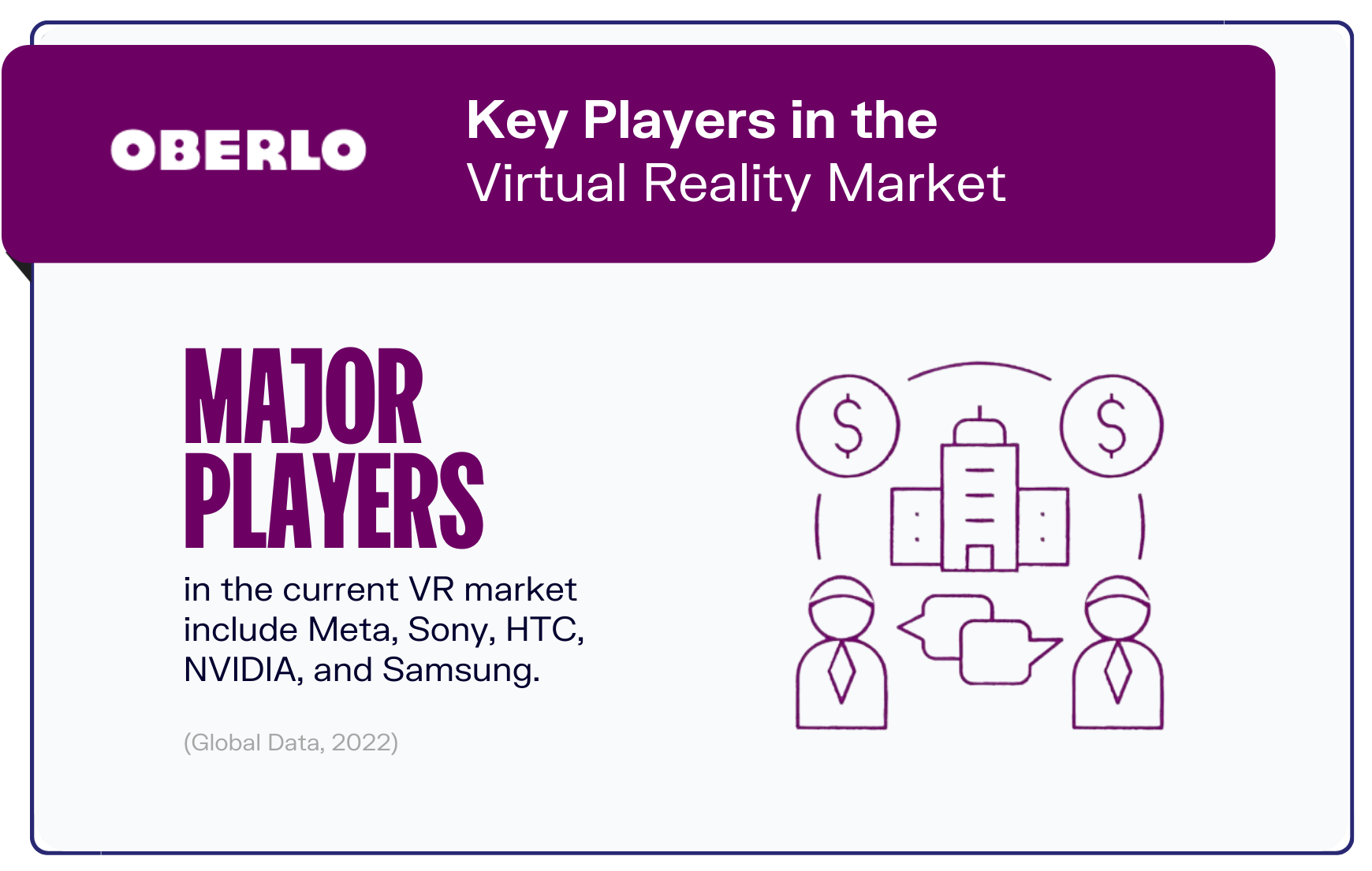
Because VR is still a relatively new technology, there are only a handful of major players in the current market.
These key players include Meta, Sony, HTC, NVIDIA, Samsung, and a few others (Global Data, 2022).
A quick look at different review sites ranking the best VR headsets in 2023 shows that products from these brands feature heavily on the list.
However, given the growing demand for virtual reality technology, you can expect big names to enter the playing field very soon. Leading tech company Apple, for example, already has a headset in the works, which they’re reportedly planning to launch sometime in 2023.
Conclusion
That’s it for the most important virtual reality statistics of 2023. We hope you now have a better idea of the direction this technology is headed toward and its potential.
Given its advancements over recent years, it’s probably safe to say that it’s only a matter of time before virtual reality takes over our lives.
Whether you’re looking to adopt the technology for your ecommerce store or be a leading seller of its devices, it’s always better to get a jump on it sooner rather than later so why not get

Summary: Virtual Reality Statistics
Here’s a summary of the Virtual Reality statistics you need to know in 2023:
- The market size of AR and VR is forecast to hit $296.9 billion in 2024 (Statista, 2021).
- From 2021 to 2028, the compound annual growth rate of the virtual reality market is 18 percent (Grand View Research, 2021).
- 14.94 million units of AR and VR headsets were shipped to customers worldwide in 2022 (IDC, 2021).
- Nearly one in five (19 percent) US consumers used VR in 2020 (AR Insider, 2020).
- 70.8 million people in the US will use virtual reality technology at least once per month in 2023 (eMarketer, 2022).
- By 2030, 23 million jobs will be using AR and VR in one way or another (PwC, 2019).
- The gaming and entertainment sectors are expected to be the biggest drivers of VR growth (Global Data, 2022).
- The VR market size is forecast to reach $92.31 billion in 2027 (Grand View Research, 2020).
- China and the US are the two leading investors in VR and spent $5.8 billion and $5.1 billion on the technology in 2020, respectively (Statista, 2019).
- The major players in the current VR market include Meta, Sony, HTC, NVIDIA, and Samsung (Global Data, 2022).



Want to Learn More?
- WooCommerce vs. Shopify: A Detailed Comparison
- 11 Best Free PDF Editor Tools
- Best Free Logo Maker: 17+ Tools and Apps for Logo Design
- 10 Best Squarespace Alternatives for Every Kind of Website
Is there anything else you’d like to know about Virtual Reality statistics and wish was included in this article? Let us know in the comments below!
